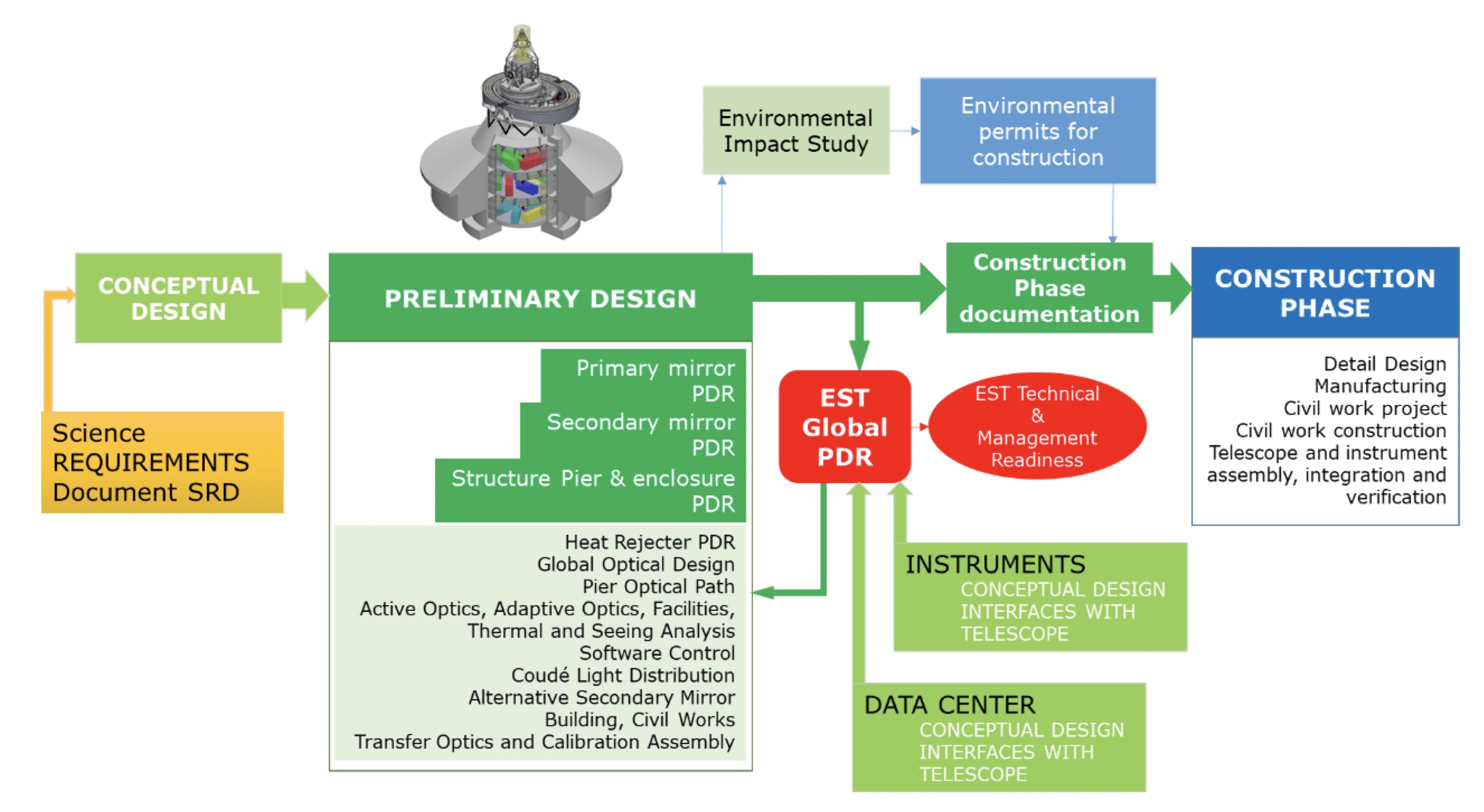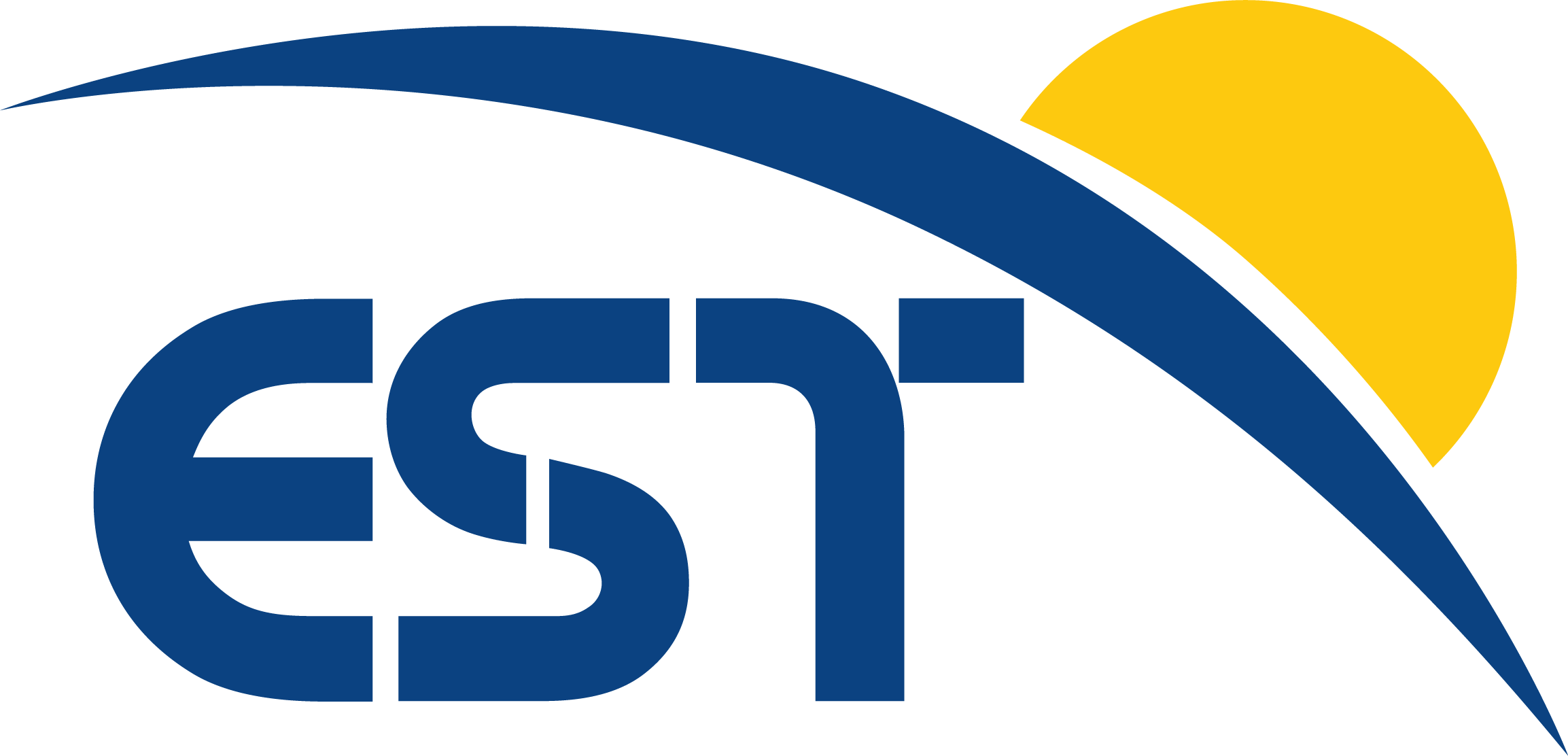The EST Preliminary Design Review (PDR) will be the main tool to establish the technical readiness of the project to proceed to the construction phase. It is scheduled for early 2024.
 Block diagram showing the EST path to construction, including main works performed in each of the different phases.
Block diagram showing the EST path to construction, including main works performed in each of the different phases.
According to the International Council on Systems Engineering, a PDR "is the revision to evaluate the technical adequacy of the design that must fulfil the top level requirements that had been broken down up to low level requirements and allocated on engineering items so that they can be verified reliably by design, by digital models analysis or by testing prototypes. The risk of the design, manufacturing, integration, maintenance and operation must be identified and mitigated to an acceptable level. The interfaces must be defined and frozen. The main design decisions must have been taken.”
The main EST Construction Plan shall define the Management Plan, the Quality Assurance Plan, the System Engineering Plan, and the Assembly, Integration and Verification Plan. Construction costs and schedule shall be estimated for the next construction and commissioning phases. After the PDR, the design will be updated with the feedback of the PDR reviewers, so that the baseline design approach is technically feasible and within the schedule and financial constraints. The detailed design documentation specifications and the construction permit paperwork shall also be produced.
The EST PDR will be a technical review to help identify weaknesses in the project in order to take correction measures and mitigate risks. An intensive review of the telescope preliminary design by leading solar scientists in the different fields covered by the EST design will be carried out. Different reviewer profiles are expected: experts on solar telescope design, maintenance and operations, experts on particular technologies used by EST, etc.
During the first half of 2023, the preliminary designs of several EST subsystems have been concluded while others are progressing towards completion. Once the design of the various subsystems is finished at the level required for PDR, the EST global PDR will be held, to cover all the engineering aspects of the telescope at preliminary design level.
The EST science instruments and Data Centre will be at a conceptual design level. Their design and integration with the telescope will be verified; therefore, they will be reviewed at the PDR, but at a less advanced level.
The current status of the design work is as follows. The Telescope Structure, Primary Mirror, Secondary Mirror, Pier and Enclosure preliminary design is complete. These subsystems have passed their specific PDR and their performance has been checked by design, analyses and/or tests.
A number of prototypes have been developed for verification purposes: M1 actuators, M1 thermal model, a 19-actuator M2, and an M2 thermal model. Tests at a wind tunnel have been performed with a scaled telescope structure and pier model using the orographic information of the construction site. Some of the tests have been carried out at the IACTEC premises after the conclusion of the design contracts.
Other subsystems are quite advanced:
- The Heat Rejecter (HR) is in the last phase of the preliminary design and the prototype is ready to undergo a test campaign. The specific HR PDR is scheduled for summer 2023.
- For the thermal and seeing analyses, thermal and fluid models have been consolidated with an external reviewer and a series of analyses have begun by the EST-PO to provide design information and seeing inputs for the error budget to be presented at the global PDR.
- The telescope Optical Design, Active Optics, Adaptive Optics, and Coudé Light Distribution are presently under a critical analysis by the EST-PO to improve their performance.
- The Pier Optical Path (POP) baseline developed by the EST-PO is advanced and an external review has been carried out to study an alternative optical design proposal.
- The required accompanying Facilities and Services are in an advanced stage, including the last modifications implemented to meet the design requirements of each telescope subsystem.
- Tests of alternative control software packages are almost finalised using demonstrators of the candidate control systems (from GTC and DKIST). In parallel, the software and control requirements of the different subsystems and the control interfaces between them show a good progress. As a result of these analyses, the software and hardware document that will include the structure of the EST Control System will soon be produced.
A few work packages are progressing with some delay:
- The development of an alternative secondary mirror prototype based on voice coils by the company Adoptica has started in May 2023. The results obtained with this technology for an adaptive secondary mirror will be presented at the PDR.
- The Transfer Optics Calibration Assembly conceptual design has been completed and the development of the preliminary design has begun. Input from other subsystems and feedback from some manufacturers are still pending. The preliminary design is expected to be ready in the coming months.
- The Building and Civil Works package has been delayed due to problems in announcing the corresponding call for tenders. The kick-off meeting for the Preliminary Construction Project is expected to take place by the end of 2023. It will include a geotechnical study at the EST site and the Environmental Impact Study to initiate the administrative procedures for the construction. The status of this package will be shown at the PDR.
The EST Science Instrumentation Suite (SIS) is currently in the conceptual design phase in order to fulfil the needs of the telescope PDR. This phase shall confirm that the system level requirements are sufficiently well understood by the SIS developers team to establish an initial system-level functional baseline with alternative instrument designs to be further traded or analysed.
 Plan for the Design, Manufacturing, AIV and Commissioning of the Science Instrumentation Suite.
Plan for the Design, Manufacturing, AIV and Commissioning of the Science Instrumentation Suite.
The different instrument concepts are being tuned to accurately fulfil the top-level system requirements that translate the needs from the different science cases described in the EST Science Requirements Document. Also, the instrument level external interfaces are being identified and analysed, particularly in terms of design, development, production and operating constraints. This work is being done with the collaboration of the SIS consortia, the EST SAG and the EST-PO. It is encompassed by the SIS Systems Engineering Plan and the SIS General Design and Interface Requirements that drive the overall SIS development according to the EST needs.
The elaboration of the PDR documentation is currently in progress. The original intention was to held this revision in mid 2023 but, due to unexpected issues and in order to achieve a high quality revision, it shall be shifted to the beginning of 2024. This milestone will pave the road towards the detailed design and construction of EST.
